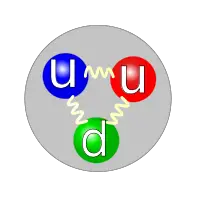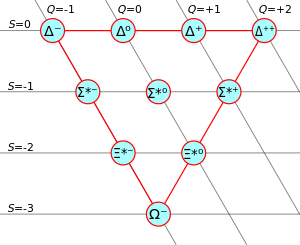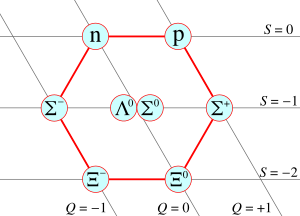Baryon

The term baryon usually refers to a subatomic particle composed of three quarks.[1] A more precise but technical definition is that a baryon is a subatomic particle with a baryon number of 1. Baryons are a subset of hadrons, (which are the particles made of quarks), and they participate in the strong interaction. They are also a subset of fermions. Well-known examples of baryons are protons and neutrons, which make up atomic nuclei, but many unstable baryons have been found as well.
Some "exotic" baryons, known as pentaquarks, are thought to be composed of four quarks and one antiquark, but their existence is not generally accepted. Each baryon has a corresponding antiparticle, called an anti-baryon, in which quarks are replaced by their corresponding antiquarks, and antiquarks (if present) are replaced by quarks.
Etymology
The term baryon is derived from the Greek word βαρύς (barys), meaning "heavy," because at the time of their naming it was believed that baryons were characterized by having greater mass than other particles.
Background
Baryons are strongly interacting fermions — that is, they experience the strong nuclear force and are described by Fermi-Dirac statistics, which apply to all particles obeying the Pauli exclusion principle. This is in contrast to bosons, which do not obey the exclusion principle.
Baryons, along with mesons, are hadrons, meaning they are particles composed of quarks. Quarks have baryon numbers of B = 1⁄3 and antiquarks have baryon number of B = −1⁄3. The term "baryon" usually refer to triquarks—baryons mades of three quarks (B = 1⁄3 + 1⁄3 + 1⁄3 = 1), but there are other "exotic" baryons, such as pentaquarks — baryons made of four quarks and one antiquark (B = 1⁄3 + 1⁄3 + 1⁄3 + 1⁄3 − 1⁄3 = 1), but their existence is not generally accepted. Theoretically, heptaquarks (5 quarks, 2 antiquarks), nonaquarks (6 quarks, 3 antiquarks), etc. could also exist.
Classification
Baryons are classified into groups according to their isospin values and quark content. There are six groups of triquarks — nucleon (N), Delta (Δ), Lambda (Λ), Sigma (Σ), Xi (Ξ), and Omega (Ω). The rules for classification are defined by the Particle Data Group. These rules consider the u, d and s quarks to be light and the c, b, and t to be heavy. The rules cover all the particles that can be made from three of each of the six quarks (up, down, strange, charm, bottom, top) — even though baryons made of top quarks are not expected to exist because of the top quark's short lifetime—but not pentaquarks.[2]:
- Baryons with three u and/or d quarks are N's (isospin 1⁄2) or Δ's (isospin 3⁄2).
- Baryons with two u and/or d quarks are Λ's (isospin 0) or Σ's (isospin 1). If the third quark is heavy, its identity is given by a subscript.
- Baryons with one u or d quark are Ξ's (isospin 1⁄2). One or two subscripts are used if one or both of the remaining quarks are heavy.
- Baryons with no u or d quarks are Ω's (isospin 0), and subscripts indicate any heavy quark content.
- Baryons that decay strongly have their masses as part of their names. For example, Sigmas (Σ) and Omegas (Ω) do not decay strongly, but Deltas (Δ(1232)), and charmed Xis (Ξ+c(2645)) do.
Quarks carry charge, so knowing the charge of a particle indirectly gives the quark content. For example, the rules above say that the Σb contains a bottom and some combination of two up and/or down quarks. A Σ0b must be one up quark (Q=2⁄3), one down quark (Q=−1⁄3), and one bottom quark (Q=−1⁄3) to have the correct charge (Q=0).
The number of baryons within one group (excluding resonances) is given by the number of isospin projections possible (2 × isospin + 1). For example there are four Δ's, corresponding to the four isospin projections of the isospin value I = 3⁄2: Δ++ (Iz = 3⁄2), Δ+(Iz = 1⁄2), Δ0(Iz = −1⁄2), and Δ−(Iz = −3⁄2). Another example would be the three Σb's, corresponding to the three isospin projections of the isospin value I = 1: Σ+b (Iz = 1), Σ0b(Iz = 0), and Σ−b(Iz = −1).
Baryonic matter
Baryonic matter is matter composed mostly of baryons (by mass), which includes atoms of any sort (and thus includes nearly all matter that we may encounter or experience in everyday life, including our bodies). Non-baryonic matter, as implied by the name, is any sort of matter that is not primarily composed of baryons. This might include such ordinary matter as neutrinos or free electrons; however, it may also include exotic species of non-baryonic dark matter, such as supersymmetric particles, axions or black holes. The distinction between baryonic and non-baryonic matter is important in cosmology, because Big Bang nucleosynthesis models set tight constraints on the amount of baryonic matter present in the early universe.
The very existence of baryons is also a significant issue in cosmology because current theory assumes that the Big Bang produced a state with equal amounts of baryons and anti-baryons. The process by which baryons came to outnumber their antiparticles is called baryogenesis. (This is distinct from a process by which leptons account for the predominance of matter over antimatter, known as leptogenesis.)
Baryogenesis
Experiments are consistent with the number of quarks in the universe being a constant and, more specifically, the number of baryons being a constant; in technical language, the total baryon number appears to be conserved. Within the prevailing Standard Model of particle physics, the number of baryons may change in multiples of three due to the action of sphalerons, although this is rare and has not been observed experimentally. Some grand unified theories of particle physics also predict that a single proton can decay, changing the baryon number by one; however, this has not yet been observed experimentally. The excess of baryons over antibaryons in the present universe is thought to be due to non-conservation of baryon number in the very early universe, though this is not well understood.
See also
- Antimatter
- Atom
- List of baryons
- Baryon number
- Charmed baryons
- Dark matter
- Fermion
- Hadron
- Lepton
- Matter
- Neutron
- Particle physics
- Proton
- Quark
- Subatomic particle
Notes
- ↑ Hadrons: Baryons and Mesons. The Particle Adventure. Retrieved September 10, 2008.
- ↑ W.-M. Yao et al. (2006). Naming scheme for hadrons. Journal of Physics G 33 (1).
ReferencesISBN links support NWE through referral fees
- Griffiths, David J. 1987. Introduction to Elementary Particles. New York: Wiley. ISBN 0471603864.
- Halzen, Francis, and Alan D. Martin. 1984. Quarks and Leptons: An Introductory Course in Modern Particle Physics. New York: Wiley. ISBN 0471887412.
- Povh, Bogdan. 1995. Particles and Nuclei: An Introduction to the Physical Concepts. Berlin: Springer-Verlag. ISBN 0387594396.
- Veltman, Martinus. 2003. Facts and Mysteries in Elementary Particle Physics. River Edge, NJ: World Scientific. ISBN 981238149X.
External links
- Hadrons. Stanford Linear Accelerator Center. Retrieved September 10, 2008.
- Hadrons. The Particle Adventure. Retrieved September 10, 2008.
- The Review of Particle Physics. Particle Data Group. Retrieved September 10, 2008.
| Particles in physics | |
|---|---|
| elementary particles | Elementary fermions: Quarks: u · d · s · c · b · t • Leptons: e · μ · τ · νe · νμ · ντ Elementary bosons: Gauge bosons: γ · g · W± · Z0 • Ghosts |
| Composite particles | Hadrons: Baryons(list)/Hyperons/Nucleons: p · n · Δ · Λ · Σ · Ξ · Ω · Ξb • Mesons(list)/Quarkonia: π · K · ρ · J/ψ · Υ Other: Atomic nucleus • Atoms • Molecules • Positronium |
| Hypothetical elementary particles | Superpartners: Axino · Dilatino · Chargino · Gluino · Gravitino · Higgsino · Neutralino · Sfermion · Slepton · Squark Other: Axion · Dilaton · Goldstone boson · Graviton · Higgs boson · Tachyon · X · Y · W' · Z' |
| Hypothetical composite particles | Exotic hadrons: Exotic baryons: Pentaquark • Exotic mesons: Glueball · Tetraquark Other: Mesonic molecule |
| Quasiparticles | Davydov soliton · Exciton · Magnon · Phonon · Plasmon · Polariton · Polaron |
Credits
New World Encyclopedia writers and editors rewrote and completed the Wikipedia article in accordance with New World Encyclopedia standards. This article abides by terms of the Creative Commons CC-by-sa 3.0 License (CC-by-sa), which may be used and disseminated with proper attribution. Credit is due under the terms of this license that can reference both the New World Encyclopedia contributors and the selfless volunteer contributors of the Wikimedia Foundation. To cite this article click here for a list of acceptable citing formats.The history of earlier contributions by wikipedians is accessible to researchers here:
The history of this article since it was imported to New World Encyclopedia:
Note: Some restrictions may apply to use of individual images which are separately licensed.

